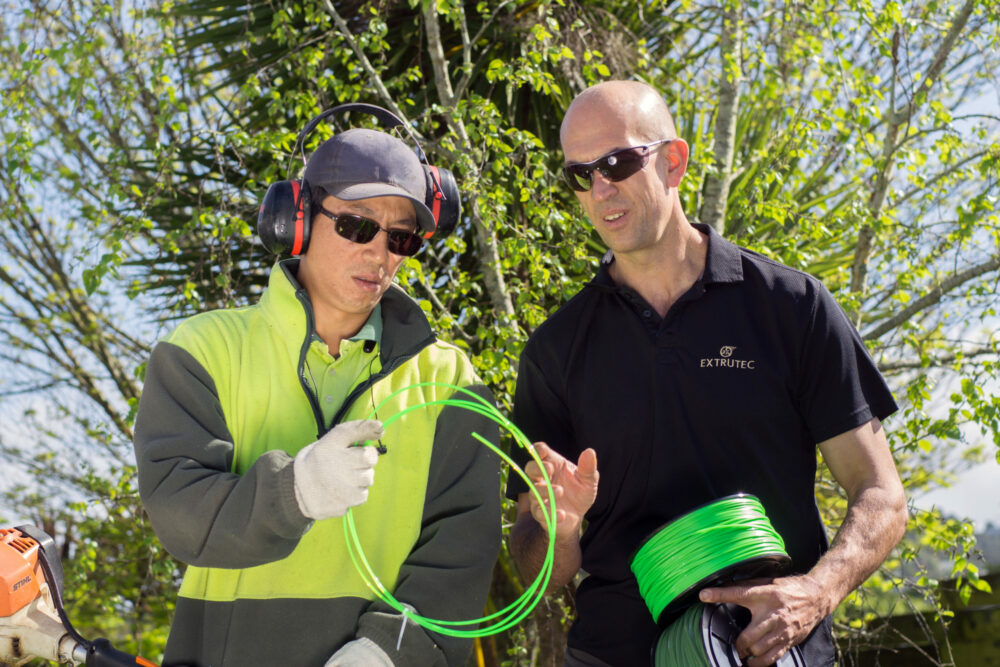Trimmer lines, and the technology used to manufacture them, have changed significantly since it was first made in the early seventies. One of the obvious developments has been around the many different trimmer line shapes now available.
Some manufacturers really let their creativity go wild in this space with shapes such as Beads, Diamond, Saw teeth, Triangle and Ellipse. It is debatable how much efficiency can be gained by these unusual shapes, but there is definitely a case to be made for multi-sided trimmer lines over just the traditional Round.
Our EVERCUT range of trimmer lines includes four shapes. The basic ROUND and SQUARE as well as HEXAGON (six-sided) and TWISTED.
Trimmer Line Shapes
Round
Trimmer lines started out round and today it is still the most popular shape. If in doubt, go for a round. It offers an all-around good option for most jobs and machines. Because it has been around the longest and is considered the most basic shape, you will find the biggest range of diameters in this shape too.
Due to its shape, round trimmer lines are considered the easiest to replace as it winds neatly and usually fits more on the spool. For this reason, it is also considered more affordable. Where trimmer line is sold by weight, as we do, we can fit a few more meters of round line onto the spool than square if they are of equivalent diameter.
The round shapes mean that the line usually wears more evenly because friction is spread more evenly, but because it does not have a cutting ‘edge’ per se, grass is ‘torn’ rather than ‘chopped’. This makes for more of a smooth, rather than crisp cut.
The best jobs to use it for are lawns with light weeds and areas with limited solid obstacles. The smaller diameters (2.0mm – 2.4mm) are good for achieving a manicured look. Larger diameters (3.0mm – 4.0mm) will, however, tolerate thicker grass and heavier weeds well.
Square
With four sharp edges, a square trimmer line provides a crisper cutting surface because it ‘chops’ rather than ‘tears’ the grass.
A square line can be a tad harder to respool as it does not wind quite as neatly as the round shape, but that minor inconvenience should be considered against the added benefit of more weight per volume. A square trimmer line has a bit more weight than the same length of a round trimmer line if they are of equivalent diameter. The benefit of this, apart from the added cutting edges, is that it adds more impact on contact so it can handle thicker grass.
The best jobs to use it for are areas with moderately thick weeds, but larger diameters such as 3.3mm – 4.0mm will tolerate some of the longest grass and heaviest weeds which makes it a favourite with council contractors and lifestyle blockers.
If you’ve heard that a square line has a greater tendency to split than a round line, it would be because it is used around hard surfaces such as rocks and fence posts. When the sharp edges (the corners) of the square hit such an object, it can develop a hairline crack which will continue to expand until it eventually breaks. This is unlikely to happen in a good quality trimmer line as the right production methods and good quality raw materials go a long way towards eliminating this problem.
To get the best performance from multi-sided lines, it is important to look after your line well by keeping it away from direct sunlight.
Hexagon
The benefit of the hexagon shaped line is that it has even more sharp cutting edges than a square trimmer line – six vs four edges. The multi-sided cutting surface makes this one ideal for thicker grass and heavier weeds. It achieves a smooth, clean cut. Think of it like those razors with multiple blades.
A challenge with this shape however can be that it does not handle heavy obstacles quite as well as a twisted or square shape. This is again due to hairline cracks that can develop in the cutting edges when obstacles are repeatedly hit. If you are working in areas where there are not many rocks or fence posts, this will not be an issue. Using a good quality trimmer line and taking good care of it will significantly reduce this problem. Taking good care of your line means storing it out of direct sunlight and keeping it hydrated. Trimmer line that has been kept for several years, particularly in a very dry environment, may deteriorate faster in the corners too.
Twisted
Twisted trimmer lines offer the most features compared to the other shapes of lines. The unique design makes this trimmer line more aerodynamic than other shapes which give it several benefits, like a reduction in drag on your trimmer motor. This in turn leads to lower noise and vibration levels and even longer life for your trimmer’s clutch.
The reduction in vibration is particularly beneficial for operators as it lessens discomfort during long periods of using a line trimmer, particularly if you suffer from ailments that affect joints.
Twisted trimmer lines are ideal to use in rugged areas and they cope well with thick and woody weeds. This shape is also the best one to use around obstacles such as solid concrete and is often the preferred option of commercial operators.

